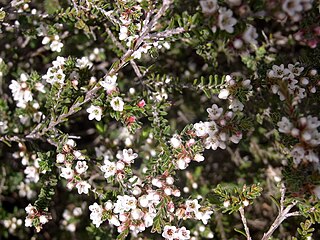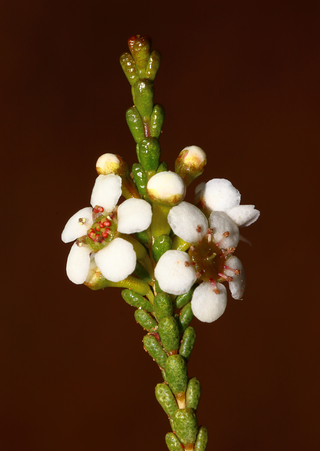
Thryptomene hexandra, commonly known as Palm Valley myrtle in the Northern Territory, is a species of flowering plant in the family Myrtaceae and is endemic to north-eastern Australia. It is an erect, much-branched shrub with linear to lance-shaped leaves and white flowers with six stamens.

Micromyrtus minutiflora is a species of flowering plant in the myrtle family and is endemic to New South Wales. It is a slender, spreading shrub with oblong to egg-shaped leaves and white flowers arranged singly in leaf axils.

Micromyrtus blakelyi is a species of flowering plant in the family Myrtaceae and is endemic to a small area near Sydney Australia. It is a low, cushion-like shrub with overlapping, keeled, linear leaves and small pink flowers arranged singly in upper leaf axils.

Micromyrtus ciliata is a species of flowering plant in the family Myrtaceae and is endemic to south-eastern continental Australia. It is a spreading to erect shrub with crowded, oblong to egg-shaped leaves and small white or pink flowers arranged singly in upper leaf axils, forming clusters on the ends of branches.
Micromyrtus acuta is a species of flowering plant in the myrtle family, Myrtaceae and is endemic to the southwest of Western Australia. It is an erect shrub with small, oblong leaves and small white flowers in the upper leaf axils.
Micromyrtus arenicola is a species of flowering plant in the myrtle family, Myrtaceae and is endemic to a small area in the southwest of Western Australia. It is an erect shrub with small, linear to narrowly egg-shaped leaves and small white flowers.
Micromyrtus barbata is a species of flowering plant in the family Myrtaceae and is endemic to inland areas of Western Australia. It is a shrub with small, overlapping, narrowly egg-shaped leaves and small white flowers arranged singly in upper leaf axils.
Micromyrtus chrysodema is a species of flowering plant in the myrtle family, Myrtaceae and is endemic to a small area of inland Western Australia. It is a densely branched shrub with small, narrowly oblong leaves and small white flowers.

Micromyrtus clavata is a species of flowering plant in the family Myrtaceae and is endemic to inland Western Australia. It is an erect, compact or sprawling shrub with erect, egg-shaped leaves with the narrower end towards the base and small white flowers arranged singly in upper leaf axils.
Micromyrtus collina is a species of flowering plant in the myrtle family, Myrtaceae and is endemic to a small area in the southwest of Western Australia. It is an erect shrub with small, linear to narrowly egg-shaped leaves and small white flowers that turn pink as they age.
Micromyrtus fimbrisepala is a species of flowering plant in the family Myrtaceae and is endemic to inland Australia. It is a shrub with overlapping, broadly elliptic to more or less round leaves and small pink flowers arranged singly in upper leaf axils.

Micromyrtus flaviflora is a species of flowering plant in the myrtle family, Myrtaceae and is endemic to inland areas of Australia. It is an erect shrub with overlapping, keeled, oblong leaves, and yellow flowers arranged singly in leaf axils, but often appearing clustered.
Micromyrtus greeniana is a species of flowering plant in the myrtle family, Myrtaceae and is endemic to a small area in the west of Western Australia. It is a spindly shrub with linear to egg-shaped leaves and small white or cream-coloured flowers.
Micromyrtus hymenonema is a species of flowering plant in the myrtle family, Myrtaceae and is endemic to inland areas of Western Australia. It is a shrub with overlapping, decussate linear leaves and pink flowers arranged singly in leaf axils with about 10 stamens in each flower.

Micromyrtus monotaxis species of the family Myrtaceae and is endemic to the Western Australia. It is an erect shrub with egg-shaped leaves with the narrower end toward the base, white flowers 4.5–6.0 mm (0.18–0.24 in) in diameter, and 10 stamens.
Micromyrtus mucronulata species of the family Myrtaceae and is endemic to the Western Australia. It is a shrub with linear to narrowly egg-shaped leaves with the narrower end toward the base, and white flowers 3.0–3.5 mm (0.12–0.14 in) in diameter.
Micromyrtus navicularis is a species of flowering plant in the myrtle family, Myrtaceae and is endemic to a small area in the south of Western Australia. It is an erect shrub with narrowly egg-shaped leaves, and small white flowers in upper leaf axils with 10 stamens in each flower.
Micromyrtus ninghanensis is a species of the flowering plant in the family Myrtaceae and is endemic to the south-west of Western Australia. It is a low, spreading shrub with egg-shaped leaves with the narrower end toward the base, white flowers 3.0–3.5 mm (0.12–0.14 in) in diameter, and 10 stamens in each flower.
Micromyrtus papillosa is a species of flowering plant in the family Myrtaceae and is endemic to the south-west of Western Australia. It is sometimes an erect or low, otherwise spreading shrub with egg-shaped leaves with the narrower end towards the base, and white flowers with 5 stamens.

Micromyrtus delicata is a species of flowering plant in the myrtle family, Myrtaceae and is endemic to a small area of northern coastal Queensland. It is a shrub with overlapping, linear to narrowly egg-shaped leaves with the narrower end towards the base and small white flowers arranged singly in leaf axils.









